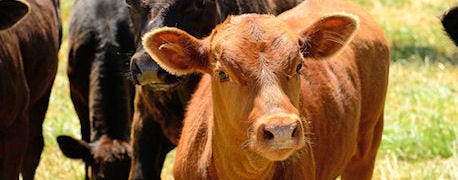November 6, 2013

Winter wheat is improving in the Southern Plains and the market for calves to graze on that wheat is heating up.
Coincidentally that is demanding wheat pasture operators look carefully at markets and value of gain for the different weight classes of cattle.
Prices for feeder cattle in the region have moved up, as has the slide or roll-back for heavier cattle classes.
Couple that with wheat that's somewhat delayed for its ability to provide pasture and you need to examine your options carefully for winter pasture, says Derrell Peel, Oklahoma State University extension livestock marketing specialist.

Big price slides from favored weight classes determines profitability for wheat-pasture calves.
Peel says the somewhat slow development of wheat pasture this year after a generally dry September implies the winter grazing period for dual-purpose wheat is likely to be limited to no more than 95 days. This further alters the profit relationships for stocker ownership on wheat pasture.
Value of gain calculations, as covered in the June issue of Beef Producer, are especially important this fall and winter.
Peel notes that through the summer and early fall, heavy feeder prices increased proportionately more than calves, based on strong feedlot demand driven by dropping corn prices. In the past month, however, calf prices in Oklahoma have increased faster than heavy feeders, with calf prices up 5 to 10 percent while heavy feeder prices have increased 3 to 4 percent. This reflects the strong preference among Oklahoma stocker producers for light stockers, typically less than 550 pounds.
This trend is common across the wheat pasture markets in the Southern Plains.
The result is sharply higher prices for the favored weight classes and a lot of roll-back, or price slide, as weights increase above the favored class.
~~~PAGE_BREAK_HERE~~~
Peel offers this example for weighted average weights and prices for Medium/Large, Number 1 steers in Oklahoma for the week ending November 1:
475 pounds averaged $203.17/cwt. or $965/head
576 pounds averaged $174.14/cwt. or $1,003/head
670 pounds averaged $168.89/cwt. or $1,132/head
772 pounds averaged $167.08/cwt. or $1,290/head
Peel adds that a short winter grazing period may limit stocker gains to roughly 200 pounds. Using just the prices above, he says the 475-pound steer has a gross margin of $167/head ($965 to $1,132) for adding 195 pounds of gain to 670 pounds.
This is an average value of gain of 86 cents per pound. Notice, too, that the 101 pounds from 475 to 576 pounds only has a value of $38/head or 38 cents per pound of gain, Peel says.
In comparison, buying the 576-pound steer only costs an additional $38/head ($1,003 vs. $965). With this animal, the gross margin for 196 pounds of gain from 576 to 772 pounds is $287/head ($,1003 to $1,290). This is a value of gain of $1.46 per pound.
Peel says in a complete budget using March Feeder futures and appropriate basis to estimate selling prices, the 475-pound steer loses $30-$35 while the 576-pound steer shows a positive return above costs of $35-$40.
"Feeder cattle market conditions may change rapidly and must be evaluated regularly," he warns. "At the current time, there are strong reasons to consider heavier beginning weights for a shortened winter grazing period. However, the bigger beginning weights may not work when more total gain is planned.
For graze-out wheat, those lighter steers will not get too heavy before May and could produce a handsome return. In that situation the later value of gain from taking the lighter steers to higher weights appear they would mostly offset the poor value of early gains.
When estimating your real value of gain, remember you must use future prices, warns Steve Swigert, Noble Foundation economist at Ardmore, Oklahoma.
Of course, one way to do that is to use the Feeder Cattle Futures price for the month closest to, but not before, your expected sale time. You can find this on the Beef Producer homepage or www.cmegroup.com. You'll need to reduce the futures price to get your net sales price, Swigert says, and your location will determine how much this basis will be.
You May Also Like




